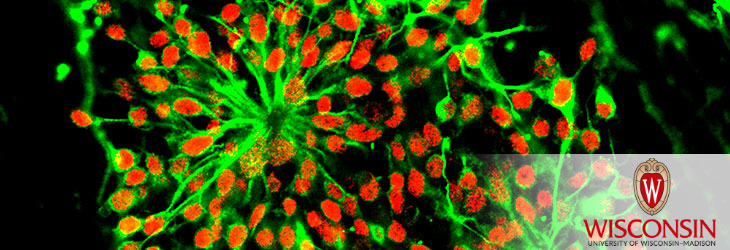Pluripotent Stem Cells

Mesenchymal Stem Cell-Educated Macrophages to Treat Radiation Damage and More
WARF: P140399US02
Inventors: Peiman Hematti, Myriam Bouchlaka, Christian Capitini
The Wisconsin Alumni Research Foundation (WARF) is seeking commercial partners interested in developing methods of using anti-inflammatory macrophages to treat and prevent radiation-induced disorders and graft-versus-host disease.
Overview
New therapies are urgently needed to protect patients exposed to high doses of radiation due to accidental trauma, terrorist attack or for medical purposes. Existing drugs (such as potassium iodide and DTPA) either shield the thyroid from damage or bind radioisotopes to prevent their absorption into tissue. None protect the bone marrow or enhance immune recovery. Furthermore, a major limiting factor in delivering enough dose of radiation to cancerous tissues is the toxicity of radiation to surrounding normal tissues.
Also, patients receiving an allogeneic hematopoietic stem cell transplant (AlloHSCT) to treat leukemia or other disorder often undergo a radiation-based conditioning regimen prior to transplant. This treatment can cause tissue damage and increase the risk of graft-versus-host disease (GVHD), a condition in which donor cells identify the recipient’s organs as “foreign” and mount an immune attack. The condition occurs in up to 60 percent of bone marrow transplants.
Because GVHD is a life-threatening complication, it typically is treated with immunosuppressive drugs for weeks to months, increasing a patient’s risk of infection and relapse.
Also, patients receiving an allogeneic hematopoietic stem cell transplant (AlloHSCT) to treat leukemia or other disorder often undergo a radiation-based conditioning regimen prior to transplant. This treatment can cause tissue damage and increase the risk of graft-versus-host disease (GVHD), a condition in which donor cells identify the recipient’s organs as “foreign” and mount an immune attack. The condition occurs in up to 60 percent of bone marrow transplants.
Because GVHD is a life-threatening complication, it typically is treated with immunosuppressive drugs for weeks to months, increasing a patient’s risk of infection and relapse.
The Invention
UW–Madison researchers have discovered that mesenchymal stem cell-educated macrophages (MEMs) have potent tissue regenerative properties that can minimize tissue damage from radiation and increase survival in clinically significant ways.
They have demonstrated in a relevant preclinical model that their new method is much superior to other forms of cellular therapy, including use of mesenchymal stem cells, for preventing and treating radiation-induced morbidity and mortality, GVHD and other conditions associated with uncontrolled inflammation. They purport that allogenic or autologous MEMs can be administered to exposed or damaged organs to treat acute, subacute or chronic radiation-induced disorder.
They have demonstrated in a relevant preclinical model that their new method is much superior to other forms of cellular therapy, including use of mesenchymal stem cells, for preventing and treating radiation-induced morbidity and mortality, GVHD and other conditions associated with uncontrolled inflammation. They purport that allogenic or autologous MEMs can be administered to exposed or damaged organs to treat acute, subacute or chronic radiation-induced disorder.
Applications
- Treating and/or preventing radiation-induced tissue damage and GVHD using human MEMs
Key Benefits
- A potential breakthrough therapy
- Exciting preliminary data
- Major commercial potential due to potential terrorist threats
Stage of Development
The researchers have completed initial work in mouse models for both GVHD and acute radiation injury, with positive results. Next steps include:
- Fully characterizing MEMs and investigating their safety and efficacy in preclinical models (ongoing)
- Development of clinical grade reparative macrophages using FDA-approved clinical reagent and methodologies
- Submitting Investigational New Drug (IND) application to FDA
- Design and implementation of a first-in-human clinical trial at UW–Madison
Additional Information
For More Information About the Inventors
Publications
- Bouchlaka et al. 2017. Human Mesenchymal Stem Cell-Educated Macrophages Are a Distinct High IL-6 Producing Subset That Confer Protection in Graft-Versus-Host-Disease and Radiation Injury Models. Biol. Blood Marrow Transplant. pii: S1083-8791(17)30306-3.
Tech Fields
For current licensing status, please contact Andy DeTienne at [javascript protected email address] or 608-960-9857